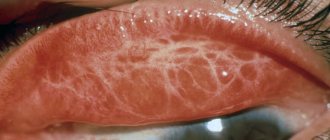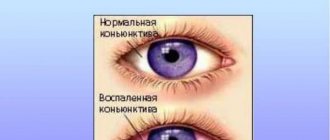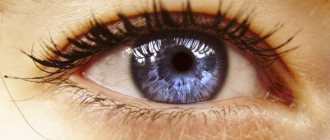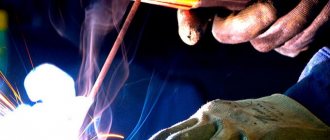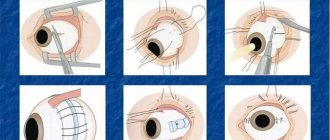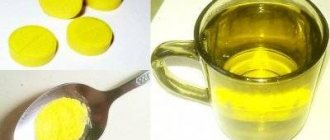In fact, demodicosis is a complex of diseases provoked by the activity of a mite of the genus Demodex - the glandular acne. The mite is found on human skin. The most common sites of localization include the facial skin, external auditory canal and eyelids.
Sign up for a free vision test
The mite is opportunistic, which means that it can live on human skin for a long time and not cause any diseases. However, against the background of a malfunction in the immune system, the body can react with an allergic reaction, which will manifest itself as various diseases, including those developing in the organ of vision and eyelids.
In particular, from the eye side, the body’s reaction will manifest itself in the following diseases:
- Demodectic blepharitis;
- Marginal keratitis;
- Blepharoconjunctivitis;
- And other inflammations of the edges of the eyelids or eyes.
The most common disease that occurs against the background of demodicosis is blepharitis of the eyelids.
In most cases, demodicosis becomes a chronic disorder that manifests itself during seasonal exacerbations.
The main symptoms of demodectic blepharitis
With this eye disease, pronounced symptoms are observed. Signs of the disease are usually noticed by the patient himself, but this does not eliminate the need to consult an ophthalmologist
to make a final diagnosis.
The most characteristic symptoms of this disorder include:
- Swelling and itching of the eyes and eyelids;
- Sticky eyelashes;
- A specific plaque, as well as small, but noticeable upon close examination, scales located along the edges of the eyelids and at the roots of the eyelashes.
If you have any of these signs, you should contact a specialist! This is necessary not only to confirm the diagnosis, but also to alleviate your condition.
Risk factors and causes
The parasite that causes demodectic blepharitis and other diseases is present in approximately 60% of adults. However, according to some data, these numbers are even higher - up to 90% of adults are carriers of the Demodex folliculorum mite, which is localized in the ducts of the sebaceous and meibomian glands. Although the statistics include adults, children are also exposed to glandular acne.
We have already said earlier that this mite is of a conditionally pathogenic nature, that is, a person can live his whole life and never encounter the negative effects of the acne gland.
Demodicosis can occur against the background of a number of diseases and decreased immunity
However, against the background of decreased immunity, chronic diseases and other negative factors, various diseases can develop in the body, affecting not only the eyes, but also the skin. In this case, the actual pathogen will not be the tick itself, but its metabolic products.
At risk are:
- Aged people;
- Patients with metabolic disorders;
- People who have reduced immunity;
- Children with diseases of the digestive system and lungs.
Sometimes signs are observed in people with visual impairments - myopia, farsightedness or astigmatism. However, this only happens in cases where the patient does not use vision correction.
Sign up for a free vision test
Factors that increase the risk of developing demodicosis include:
- Using cosmetics with hormonal components;
- Regular use of a solarium;
- Excessive consumption of caffeinated drinks;
- Stress;
- General fatigue of the body;
- Chronic lack of sleep;
- Chronic infections;
- Avitaminosis;
- Eye surgeries.
Reasons for the development of demodicosis of the eyelids
A person often does not suspect what dangerous microorganisms parasitize his skin and mucous membranes of the eyelids. The rapid activation of Demodex parasites is provoked by the following external and internal factors that are especially favorable for the development of mites:
- A decrease in the body’s resistance to infections due to chronic, sluggish, but internal diseases of the liver, lungs, kidneys, stomach, and other organs that take away a person’s internal energy.
- Allergies that undermine immune defenses.
- Endocrine diseases leading to hormonal imbalances.
- Stressful conditions that worsen the trophism of eye tissues and tear formation.
- Meibomian gland dysfunction: pathological fat secretion or inflammation.
- Infectious eye diseases.
- Violation of the simplest rules of personal hygiene leads to infection with mites from patients with demodicosis.
Factors that provoke the activation of Demodex include environmental conditions unfavorable for humans (but very much loved by parasites): hot air, high humidity.
If it was not possible to avoid demodicosis, you should immediately visit an ophthalmologist, parasitologist, or dermatologist. The doctor will prescribe antiparasitic drops and Demodex ointment, which will allow you to remove ticks in the shortest possible time.
Diagnosis of demodectic blepharitis
If the disease is in its early stages, the patient is referred for laboratory testing to make a diagnosis. This allows you to exclude other factors that could cause blepharitis.
The laboratory test does not require any preparation: a few eyelashes are simply taken from both eyes of the patient for analysis. Next, the eyelashes are placed under a microscope, exposed to glycerin, and examined for the presence of mites or their metabolic products.
If demodicosis has become chronic, the doctor
can detect it during normal visual inspection. The presence of an inflammatory process is indicated by swelling of the eyes and hyperemia of the eyelids, that is, a condition in which the vessels of the eyelids are filled with blood and stand out against the background of the skin as a pronounced “cobweb”. But the most characteristic sign for making a diagnosis is the scales that are found near the line where the eyelashes grow.
Chronic demodicosis can be diagnosed by visual examination.
The need for additional laboratory testing in this case remains at the discretion of the doctor; often it is not necessary.
Treatment of demodectic blepharitis
The course of treatment is drawn up by an ophthalmologist
. Only a specialist can select and combine medications correctly; self-medication is unacceptable!
Drug therapy
The doctor selects medications based on several factors, including the degree of the disease and the patient’s age. The following types of drugs may be prescribed to treat blepharitis:
- Antimicrobial agents, mainly in the form of ointments;
- Antiseptics (selected by a doctor);
- Tear replacement therapy - the patient may experience discomfort in the eyes in addition to itching. To eliminate them, the specialist prescribes lipid-containing moisturizing preparations of high or medium viscosity;
- Anti-inflammatory drugs, usually hormonal ointments with corticosteroids;
- Antibiotics in drops or ointments. Antibiotic therapy is prescribed in rare cases when inflammation of the eyelids has reached a high degree of development and is no longer amenable to other types of treatment.
Non-drug therapy
At the discretion of the specialist, additional non-drug therapeutic procedures may be prescribed, including eyelid massage. As a rule, eyelid massage is accompanied by special warm compresses. The patient can perform these procedures independently, at home.
After compresses and eyelid massage, the patient can treat certain areas of the skin with an antiseptic and antiparasitic agent.
As an additional effect on demodicosis, magnetic or ozone therapy can be prescribed, which is carried out in the clinic.
How long does it take to treat demodicosis?
Although the first signs of improvement, as a rule, occur within a few days from the start of therapy, treatment lasts quite a long time - from two weeks to a month.
Treatment of demodicosis can last up to a month
If the patient follows all the doctor’s instructions, but the condition of the eyes and eyelids does not improve within a week, it is necessary to contact an ophthalmologist
to select more effective therapy.
Side effects
Such drugs have common side effects , which, according to patients, develop quite rarely when used correctly.
The most common side effect is allergic reactions.
They occur due to individual intolerance or sensitivity to certain components of the drug.
Allergies can manifest as itching, burning and redness of the treated areas of the eyelids.
Additional symptomatic treatment in such cases is not required, but the use of the drug should be discontinued and treatment with any of the analogues should be continued.
You should know! Often, ointments for demodicosis, if accidentally ingested, can cause nausea, cramps and pain in the stomach, and digestive disorders.
In such situations, it is recommended to perform gastric lavage.
Remedies for demodicosis can be sold with or without a prescription.
But even when purchasing an over-the-counter drug, you should consult a dermatologist.
This is necessary primarily to assess the effectiveness of a particular drug, since in the later stages of the disease some of the drugs may be ineffective.
Also, before purchasing ointments, you should familiarize yourself with the contraindications indicated in the instructions and the possibility of joint use with other drugs.
Recommendations for the prevention of demodectic blepharitis
Prevention of the disease begins with eliminating risk factors that influence the reappearance of demodicosis. The patient needs to receive therapy aimed at improving immunity and eliminating vitamin deficiency, as well as treating chronic diseases.
In addition, it is important to undergo a vision test and ensure the necessary correction with glasses and contact lenses.
Regular eye exams are an important part of preventing demodectic blepharitis.
For preventive purposes, it is also recommended to be observed by a dermatologist, especially if the patient has acne - in this case it is important to control the inflammatory process.
Sign up for a free vision test
Hygiene measures
A patient with a history of demodicosis is recommended to have his own set of bed linen, towels, and handkerchiefs. All personal hygiene items must be kept clean.
Touching your eyes and face with dirty hands is unacceptable; before each touch, you must thoroughly wash your hands with antibacterial soap. During the period of exacerbation, you should abandon contact lenses in favor of glasses.
It is recommended to continue independent procedures - warm compresses and eyelid massage.
Lifestyle
Women should limit their use of cosmetics. Avoiding oily creams for the face and eyelids also reduces the likelihood of clinical manifestations of demodicosis.
It is important to use antiseptics in cases where it is impossible to wash your hands with soap.
Diet
As such, a diet for demodectic blepharitis is not necessary. However, experts recommend reducing the percentage of allergenic products. These include citrus fruits and some seafood.
At the same time, it is recommended to take an OMEGA-3 supplement due to its positive effect on eyelid inflammation. However, before this, you need to consult with a specialist; self-prescription of medications and active supplements is unacceptable!
List of ointments for demodicosis on the face and eyes
Below is the main list of ointments for demodicosis, with their description and rules of use.
Sulfuric
Brief description: Sulfur ointment for demodicosis is used very often. The main substance that fights the disease is sulfur. Vaseline acts as an additional component. This drug belongs to the group of drugs that are actively used to fight microbes and parasites.
Indications for use: Doctors often prescribe sulfur ointment for bacterial lesions of the face. It exhibits its effective properties in getting rid of seborrhea, psoriasis, lichen, sycosis and mycoses and other pathologies. It has also been found to be effective against scabies.
Directions for use: Parts infected with demodicosis are pre-cleaned before treatment. Calendula infusion is an excellent cleanser. A small amount is applied to the infected parts of the face several times a day (up to three times). Its layer depends on how often the drug is used and on the disease itself.
Permethrin
Brief description: The main substances that fight the cause of infection are pyretoids. These components, synthesized artificially, pass through the protective shell of the tick, affecting its limbs, immobilizing the carrier of the disease. In addition, they cause mutations in DNA synthesis, thereby disrupting the tick's reproduction process. Not toxic to humans.
Indications for use: Permethrin ointment is prescribed for various skin diseases, for example, demodicosis, scabies and other pathologies.
Directions for use: Permethrin ointment for demodicosis is applied externally. It is used to treat parts infected with mites, rubbing with light movements (you can also use it on your eyelids). Typically, the application is performed once, but if complications are detected, the procedure is repeated twice, and in case of severe infection - three times a day. It can be washed off only 12 hours after treating the infestations. The therapeutic course lasts two weeks, and if there are signs of partial removal of the simplest microorganisms causing the disease, it is repeated.
Ichthyol
Brief description: It is a local antiseptic. It has anti-inflammatory, as well as antiseptic and analgesic properties. Its active components do not penetrate the human circulatory system.
Indications for use: Effectively used for healing affected areas from demodicosis, eczema, burns, and various types of dermatitis. It also has a positive effect on joint pain.
Directions for use: Ichthyol ointment for demodicosis is used as an external remedy. The affected parts of the face are covered with a layer of the drug, but it is imperative that no rubbing movements are performed (this ointment can also be used for the skin of the eyelids). When a small layer has been applied to the infected parts, they are covered with gauze. The duration of the procedure depends on the individual characteristics of the person. Usually, after observing varying degrees of infection, doctors recommend applying it to problem areas 2-3 times a day.
Synthomycin
Brief description: This drug is considered an antibiotic with a broad spectrum of action, which is aimed at eliminating microorganisms. The main active component, chloramphenicol, penetrates microbial cells and binds to certain substances in bacterial ribosomes. As a result, the transport of amino acids slows down, and this, in turn, involves the process of changing the creation of peptide bonds and the synthesis of protein structures.
Indications for use: Used for pustular skin lesions, ulcers, purulent wounds, for healing affected areas with II and III degree burns. External treatment must be carried out when treating skin infections caused by protozoan microorganisms. In complicated cases, the drug is used together with the necessary antibacterial creams.
Directions for use: Syntomycin ointment treats demodicosis as an external preparation. This medicine is applied to parts of the face (as well as eyelids) affected by the disease, and a gauze application is placed on top along with compression or parchment paper. Paper is just an additional attribute. A person changes gauze after one, three or five days. For areas that do not heal for a long time, such as burns, 5% and 10% ointment is used.
Yam
Brief description: Pharmaceutical preparation with fungicidal and bactericidal properties. The main active ingredients are sulfur, turpentine, petroleum jelly, tar, acetylsalicylic acid, zinc oxide. It also exhibits healing properties when treating the skin of a person suffering from various types of dermatitis.
Indications for use: It is used mainly for demodicosis, eczema, various types of dermatitis, as well as other skin lesions.
Directions for use: Ointment for demodicosis Yam is used to treat the affected parts of the face (with caution it can also be used on the eyelids), applying a small layer of the drug 1-2 times a day. It can be kept on the treated areas for no more than thirty minutes, and it is also necessary to monitor the time of treatment of the foci of the disease. The duration of the course of therapy is determined by a dermatologist. As a rule, it is 10-14 days. After completing the course, the patient undergoes microscopic examination, this is done to clarify the degree of elimination of microorganisms in the patient. If the cause of infection has not been completely destroyed, the course of therapy is re-prescribed.
Zinc
Brief description: Another of the drugs that gives effective results when infecting the external integument of a person. It contains two active ingredients, petroleum jelly and zinc. Zinc oxide has a strong anti-inflammatory effect and has a drying effect on the skin. In addition, it eliminates inflammation and is a catalyst in the restoration of infected areas of the body.
Indications for use: Prescribed for therapeutic treatment for a wide range of diseases: eczema, diaper rash, various types of dermatitis, burns of all degrees, weak wounds and pimples, ulcers and other lesions that appear on the surface of the human body.
Directions for use: Zinc ointment for facial demodicosis is an external preparation. A small amount of medicine is applied to the infected parts. If you want to use it on your eyelids, then you need to do this with extreme caution, since you should not allow the ointment to get into your eyes. If this does happen, immediately rinse your eyes with water. The period of therapeutic sessions is determined by a dermatologist based on an analysis of the degree of pathology and the presence of complications. As a standard, apply several times (no more than five) a day. The number of required sessions is determined by the doctor.
Benzyl benzoate
Brief description: Benzyl benzoate ointment is traditionally used in the treatment of facial demodicosis, as it is highly effective. It has antiparasitic properties and, thereby, destroys the cause of the pathology. Due to the fact that this medicine is quite aggressive to the surface of the human body, you should be careful when using it during the treatment process. Under no circumstances should this drug be used on the skin around the eyes and eyelids!
Indications for use: Mainly used for skin diseases caused by parasites. The drug is used for pediculosis and other skin pathologies. The main therapeutic effect is based on penetration through the protective cover of the parasite, which ultimately leads to its death. This product also prevents the reproductive process of pathogens due to its bacteriostatic properties.
Directions for use: The ointment is used to treat demodicosis of the face. To do this, apply a small amount of the drug to the affected areas, making sure that it does not interact with the eyes. The duration of therapeutic operations is determined by the doctor, having carried out all the necessary studies to determine the main symptoms and the degree of infection.
Aversectin
Brief description: Prescribed for various skin diseases. The interaction of the active component of the drug with the tissues of microorganisms causes nervous paralysis and starts the process of destroying pathogens. As a rule, it is used in veterinary practice, so before use it is advised to check the reaction of human skin by applying a small amount of ointment to the affected areas. If it provokes unpleasant sensations, such as itching or burning, the appearance of swelling, rashes of various kinds, then the use of the drug is strictly prohibited.
Indications for use: External action drug. Used to treat various types of skin dermatitis. There is also a positive effect in the treatment of burns and minor wounds. The components of the drug may interact aggressively with human skin.
Method of use: Aversectin ointment is recommended by most dermatologists for the treatment of demodicosis in humans in short courses - five days each. It is applied at night to the infected areas of the face once a day. This is followed by a break of two days. The next day, application of the product is repeated. Full course – five courses of seven days. After two weeks after completing the course, the patient undergoes laboratory control, where the degree of destruction of the cause of the pathology is determined. If the degree is partial, the doctor prescribes this course again. This drug is not recommended for the treatment of demodicosis of the eyelids.
Vishnevsky ointment
Brief description: Scientific name – Balsamic liniment according to Vishnevsky. It is a liniment - a substance that combines the physical properties of ointment and liquid. The active components, xeroform and birch tar, give the drug antiseptic, bactericidal, anti-inflammatory properties. They irritate the skin, which causes an increase in blood circulation in the treated areas, and also accelerates the healing process of the affected parts of the body.
Indications for use: Used to treat skin areas with: boils, frostbite, burns, lymphadenitis and other skin lesions. In addition, it has proven itself well for hemorrhoids, nonspecific diseases of the female genital organs, and radiculitis.
Directions for use: Vishnevsky ointment for demodicosis of the face is applied externally. A small layer of the drug is applied to the affected parts of the face (can also be used on the eyelids). After this, a bandage is applied, folded several times. The bandage is pre-impregnated with liniment. This bandage is fixed on the patient's face. Before using the medicine, it is recommended to consult a doctor; he will also determine the duration of both the treatment period itself and the time for fixing the bandage.
Tetracycline
Brief description: Bacteriostatic antibiotic. The action of the drug is based on the interaction of active components with microorganisms, which ultimately stops the reproduction process at the level of amino acids (proteins). Used for diseases caused by bacteria and parasites.
Indications for use: It has proven itself well for inflammation around the eyes (conjunctivitis, blepharitis, keratitis and other pathologies) and skin infections - eczema, furunculosis, rashes, folliculitis and others.
Directions for use: Tetracycline ointment for demodicosis of the face and eyelids is used from one to several weeks. The accuracy of the duration of the course of therapy depends on the degree of damage and is clarified by a dermatologist. Before applying the drug, traces of cosmetics and sebaceous secretions must be removed from the treated areas. Apply a fairly large layer of medicinal ointment to gauze and apply to the affected area. Leave this compress for 12 hours. The procedure is repeated every day.
Apit
Brief description: Apit ointment for demodicosis is a preparation made from an alcoholic extract of propolis, petroleum jelly and lanolin. When using it, the patient feels an anesthetic effect. Active components accelerate the healing process of wounds from skin pathologies.
Indications for use: Prescribed for various types of dermatitis (eczema, scabies, etc.), diseases of an obstetric and gynecological nature (vaginitis, vestibulitis, cervicitis). It is better not to use on the skin of the eyelids.
Directions for use: Ointment for demodicosis Apit is applied externally, both as applications and as medicinal dressings. Tampons are soaked in medicine and applied to parts of the face infected with the disease. Such dressings must be changed several times during the day. The duration of therapeutic sessions depends on the individual characteristics of the patient: the degree of infection, the presence of complications, the condition of the skin.
conclusions
- Demodectic blepharitis is the most common eye reaction of the body to waste products of a parasite that lives on the skin of the face;
- The disease is more susceptible to the elderly, children with diseases of the gastrointestinal tract and lungs, as well as patients with systemic diseases;
- In some cases, the cause of inflammation of the eyelids may also be a visual disturbance that cannot be corrected with glasses or contact lenses;
- The course of treatment takes from two weeks to a month. Therapy is prescribed by an ophthalmologist
; - For preventive purposes, it is recommended to carefully monitor personal hygiene, see a dermatologist, and, if possible, eliminate all risk factors.
Treatment of demodicosis with folk remedies
- Dilute the juice with water in a 1:1 ratio. Soak a linen napkin or several layers of gauze in the resulting solution, squeeze lightly and apply to the face for 15 minutes. Aloe juice can be used without fear for your eyes. Compresses are made from several layers of gauze soaked in aloe juice (it is better to dilute it equally with water, as it dries quite quickly). Apply for 15 minutes. 1 time every other day, for one and a half months. It would be good to do a massage (rubbing) of the eyelids first.
- Soak a gauze pad in half a glass of cabbage juice and apply it to your face for 15-20 minutes. Re-wet the napkin in the juice as it dries. The course of this treatment is 20-25 procedures, which should be carried out every other day.
- 2 tbsp. Pour a glass of boiling water over spoons of heart-shaped linden flowers, boil in a water bath for 10 minutes, strain (filter). Wipe your nose with warm broth in the early morning and in the evening, but not just before going out into the cold.
- Apply wipes soaked in the juice of the freshest and ripe tomatoes to your face for 15 minutes every day. The course of treatment is 20 procedures.
- 1-2 tbsp. spoons of dried flowers pour a glass of water, boil for 10 minutes, cool and strain (filter). Apply compresses to the face 2-3 times a week, alternating hot and cold chamomile decoction.
- Mix 3 g of flammable sulfur, 2 tbsp. spoons of birch tar, 1.5 tbsp. spoons of melted lard, put on fire and bring to a boil. Boil for 2 minutes, pour into a jar and close with a lid, cool. Lubricate your nose with the mixture overnight. In the morning, wash your face with warm water and soap. The course is at least three months.
- Wash your face in the morning with tannin, oak bark, salicylic-ichthyol soap.
- treatment of the edges of the eyelids with alcohol solutions of herbs (tincture of calendula, eucalyptus) or 70% solution of alcohol with ether + treatment of the skin in the area: eyebrows, forehead, wings of the nose, chin, external auditory canal;
- Eyelid massage;
- Wipe them with laundry or tar soap, take a match with cotton wool or an eye stick, soap the surface, moisten it and rub it into the edges of the eyelids, let it dry. The remedy will work until the morning;
- Zinc drops help a lot: 2 drops 3 times a day. And, as a preventive measure against demodicosis, it is much better to sleep on pillows made of synthetic fillers.
Treatment of the edges of the eyelids can be carried out with a solution of dimexide, water infusion, or alcohol tincture of wormwood. For the eyes, use eye drops of zinc sulfate in boric acid, alkaline drops, desensitizing agents, and artificial tears for dry eye syndrome. But this is a symptomatic treatment, and if the cause of the appearance is not removed, wait again in a month or two.
BadZdorov.ru Traditional medicine recipes will cure diseases and give you health!

